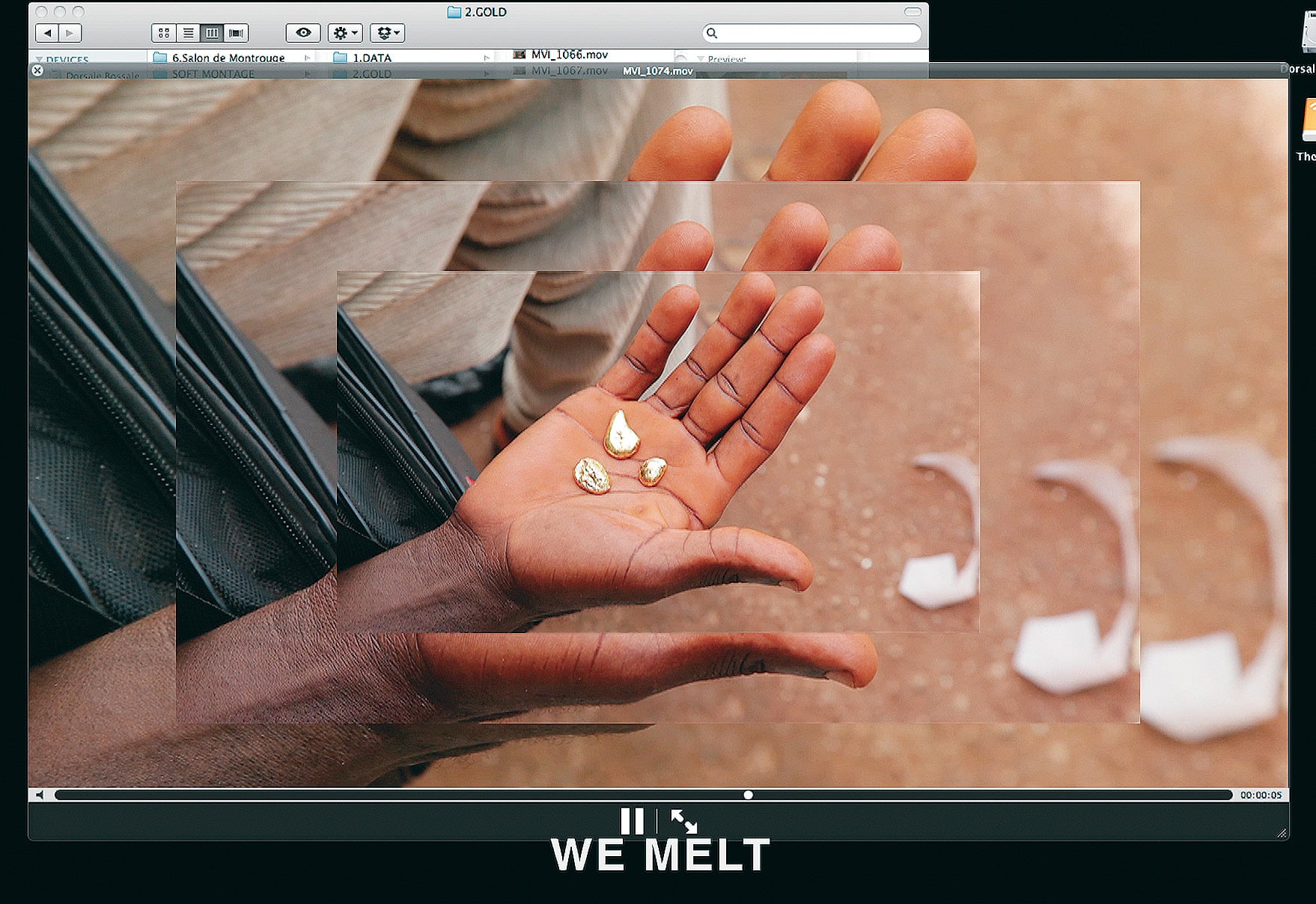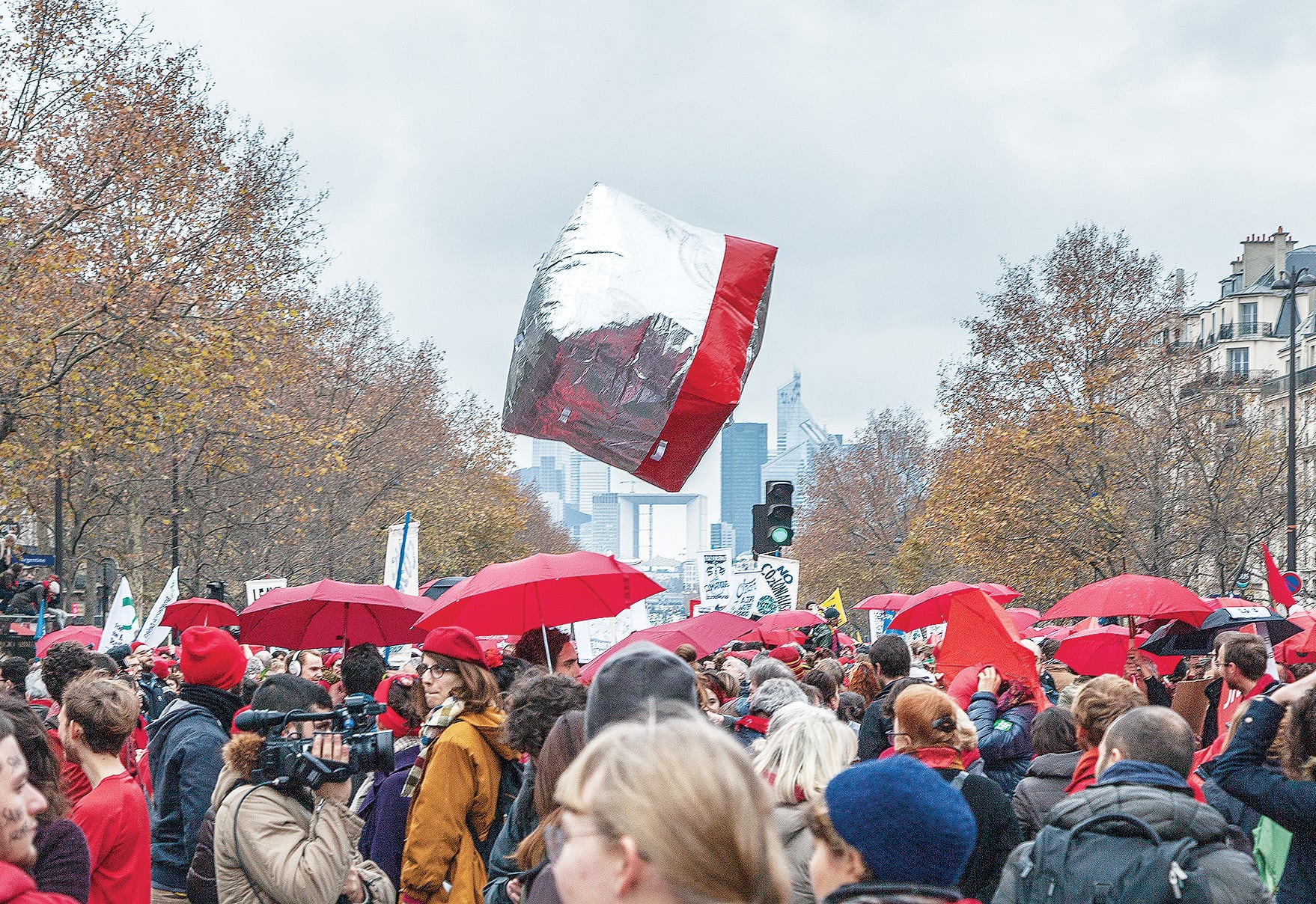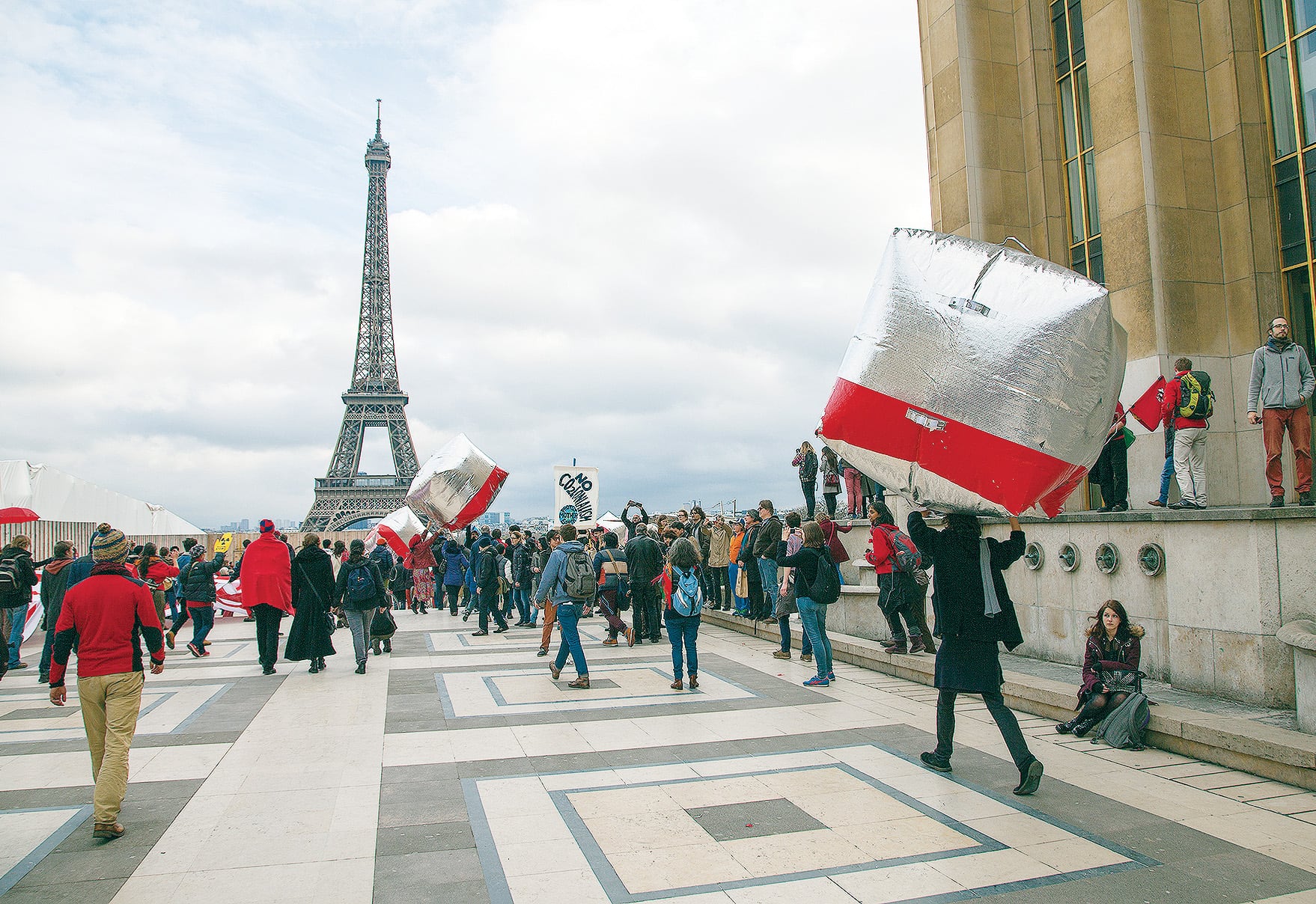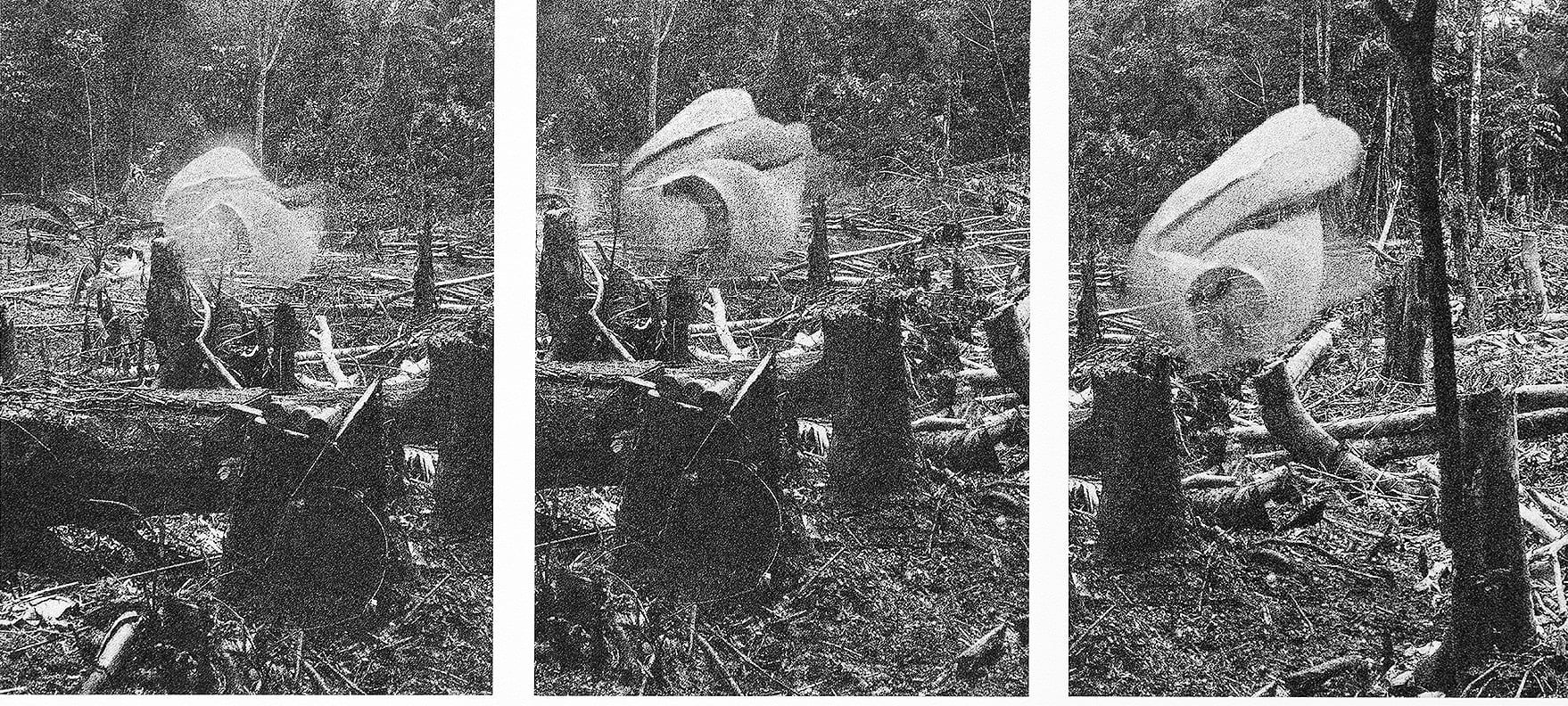It’s early October and I’ve come to Bétonsalon Centre for Art and Research for the opening of Co-Workers: Beyond Disaster. Three months since arriving in Paris, disaster is already decidedly in the air. The United Nations COP21 climate change talks (expected by most to be its own car crash of performative political inaction) are not far off, and there’s more attention than usual on the spiralling ecological crises unfolding elsewhere in the world, not to mention the human catastrophe heating up in refugee camps at the edges of Europe, in warehouse squats outside the Péripherique and along the banks of the Seine. This is, we’re told, the era of the Anthropocene (or if you prefer, the capitalocene or manthropocene), where moving beyond a point of crisis — one of ‘our’ own making, at least in part — is increasingly the subject, or project, of contemporary artistic practice. Here in the glass-fronted exhibition space at University Paris Diderot, a collection of ‘things’ are assembled that point outside, towards places and practices confronting shades of disaster in a variety of material-discursive reconfigurations.1 Through them, and an associated program of events, Dark Series, curators Garance Malivel and Mélanie Bouteloup want to address ‘the transformations and forms of collective action that disaster occasions’, taking the concept of a ‘common work’ as a way of rethinking how we construct and inhabit our environment(s).2
Emphasising speculative narrative forms, the show attempts to move away from an anthropocentric perspective to one accounting for other living and nonliving agencies, in which categories like human/nonhuman, fiction/reality, and finite/infinite come undone. Directly applied to one main wall are a series of thirteen giclée prints by Brazilian artist Daniel Steegmann Mangrané, Novos Estudos (2013), which sit precisely in this space of ambiguity. In black and white scenes of logged forest a swirling shape hovers as if conjured by nineteenth century spirit photographer William Mumler. Mangrané’s double exposures depict, however, a different order of deception, overlaying exponential Amazonian deforestation with pictures of a jellyfish taken by Brazilian multinational oil company Petrobras whilst inspecting underwater pipelines in the Gulf of Mexico. This imaginative disintegration draws on the radical multi-naturalist world of anthropologist Eduardo Viveiros de Castro, in which all beings and matter share personhood, as well as the spectator’s own perceptual-intellectual encounter with the constructed image.3 In 16mm (2015), part of a compact solo show in the well-heeled Marais district that bears the official imprint of COP21, Mangrané further flattens the perspective of viewer, object and setting, filming with a modified camera a slow glide forward along a suspended track — the length of a standard 16mm reel — in the treetops of Brazil’s conflict-ridden Mata Atlântica forest.
Other layers of relational causality at work in such a geography are picked up by Paolo Tavares in the panel Urban Development & Climate Change in the Global South, part of the Dark Series set of workshops, conversations and assemblies, which includes speculative fiction writing classes and a working group, Seule contre l’Univert (a play on ‘alone against the universe’) led by curator Eva Barois de Caevel to share and develop responses to cases of urban conspiracy or municipal dissimulation. In his talk Tavares, reading the forest as architecture, describes what he calls ‘a botanical archeology of genocide’.4 By carbon-dating sections of Amazonian forest, his research identifies a cartography of missing Indigenous villages, where younger trees have filled in territorial voids once home to other modes of life and being in relation to the land that are inimical to the project of (national) development. The memory of these ‘double disappeared’ political victims is effectively held in the trees and soil, which act as co-workers in revealing power as a geological force and the structural links between modernity and colonialism. As Tavares observes, it’s no stretch to extend this to the violence of displaced populations and climate refugees that make up the new geopolitical and geophysical conditions under which we are all living.
Decamping to the city’s north, the concurrent exhibition at Khiasma, Les propriétés du sol, approaches soil not only as the central actor in a thematic frame, but also a narrative space and dynamic political agent.5 Curated by Olivier Marboeuf, this immersive show proposes a political archaeology in which human conceptions of borders and acts of appropriation are complicated by the ‘story of stones’ and the soil’s own version of events. Works like Filipa César’s film essay, Mined Soil (2014), question how archives can be expanded to include other kinds of nonhuman histories, layering together different perspectives, time scales and methodological orientations. César’s film traces Guinean agronomist and political activist Amílcar Cabral through a reflection on mining in Portuguese-occupied Africa, projecting images onto figures reading source material in which soil shape-shifts between a site of neocolonial imperialism, a repository of memory and a ground for strategic guerrilla maps. Further on we find an installation by Vincent Chévillon, Metamorphoses (Scrimshaws) (2015). Here a neat cabinet of bones, butterfly specimens, diagrams and oddly melding artefacts — the artist’s own collected curiosities — revisit the interstitial wanderings of the eighteenth century whaler and the dynamic capacity of objects to destabilise stories of colonial encounter. Opposite this, Louis Henderson’s video All that is solid (2014), described as ‘an archaeology of the internet as a new space of exploitation but also a possible site of animistic power and anti colonial struggle’6 spins out the material baggage of the Cloud to its back-end in illegal mineral extraction in Ghana and its eventual return as redundant e-waste, picked over by locals for remnant precious metals in a reversal of Western colonial exploitation. Presented as a desktop view in which layered clips (Henderson’s own or Google grabs) are visibly assembled, the work grasps the materiality of technology and its intimate entanglement in how we produce and perceive the world across different bodies and geographies.

Back at Bétonsalon there are other bodies literally at work in the room, a team of appropriated Formica Rufa ants quietly marching through the constructed ecology of gypsum (from the gallery walls) and White Sands from New Mexico that make up Melissa Dubbin & Aaron S. Davidson’s Myrmomancy (2015). The insects, fed milk and honey by gallery staff each night, refer to Ursula K. Le Guin’s short story, The Author of the Acacia Seeds, and are lit through garnets excavated by their own labour in the desert. They form part of a translation exercise in dialogue with Violaine Sautter, geologist and ‘geolinguist’, on metamorphic stones that migrate from the centre of the earth. Sautter writes in an accompanying text of how the three minerals in an eclogite (also on display), including garnet, ‘chose each other in an ultimate assembling. They tell us to think in reverse’. On another wall by the entrance, a series of digitised weather reports from David Ohle’s 1972 dystopian novel, Motorman, deliver a stream of melancholic and slightly hallucinogenic forecasts, invoking the performative power of language against the spectre of ecological and political collapse:
Two suns cooling at the horizon, restless moons, animals should be sheltered, travelers are warned, all craft should return to port, possible flood on The Jelly … Seven oval spheres in Scorpio according to the charts, probable deadly Friday, chance of a two-Tuesday mock week…
Of course these words were chosen before what must be one of the most deadly Fridays that Paris has seen, that of 13 November 2015, when a handful of isis operatives killed 130 people and injured 368 in co-ordinated terrorist attacks across the city.
you can still see every detail clearly, but can’t grasp the meaning.7
We get ahead of ourselves. Co-Workers has a second part, opening a day later at the more imposing Musée d’Art Moderne de la Ville de Paris. The vernissage of Co-Workers: The Artist as Network has a rather different feel, with snaking queues to get in and the ambiance and paraphernalia of an upmarket trade fair or showroom. Holding my mini plastic cup of instant coffee, courtesy of Ryan Trecartin’s I-Be AREA (2007), the relations of objects and people here appear to be (net)working together in an altogether different mode, and towards other ends. Certainly the strategies and languages used are closer to corporate advertising and high-end design. There’s even a ‘trailer’ by New York collective DIS and Paris ASMR, You can relax now (2015), in which a smiling young man whispers to us from a flatscreen at the entrance about the offerings inside. This show is bigger than its counterpart, focusing on the new modes of communication co-produced by the internet and mobile technologies, the ‘internet of things’ now infiltrating every aspect of life, with its critical positions at times harder to distinguish. The works are mostly by post-internet generation artists trained in the 2000s, many following the shift from the dematerialisation of art to the rematerialisation of the internet. All have a similar slickness of production, set in an open plan environment designed by DIS to evoke a transit lounge or co-working hub, where images, objects, data (and presumably capital) might freely circulate. The collective is also responsible for ‘The Island (KEN)’, a concept space partnered with a kitchen/bathroom company that houses a central bank of screen works and hosts meetings and talks. If climate change is ‘a war on the poor’ led by Western consumption-heavy lifestyles, then we may here be comfortably occupied in the belly of the beast.8
After channel surfing through videos, installations and ‘immersive spaces’, I watch Hito Steyerl’s video Liquidity Inc. (2014) from its cushioned blue seating wall, a soft version of the tidal wave lurking at the edges of an instructional tale of trade, risk and fluidity. ‘Empty your mind, be formless, shapeless, like water’, Bruce Lee coaxes from a mobile screen, on the big screen. Over in The Island, Andrew Norman Wilson’s Workers Leaving the Googleplex (2009–11) offers a drily funny take on class politics and the myth of transparency at Google, following his efforts to interview members of the elite yellow-badge tier (the scanners for Google Books) that resulted in the termination of his own employment there. The video went viral on its release, feeding back into the distributed system of ‘non-human scaled complexity’ that it critiques. The curators of Beyond Disaster write about our ambivalence towards an increasingly complex interconnectedness that enables new modes of exchange and of being, but also brings with it a loss of legibility, what artist Ian Cheng calls the most intimate crisis we face. Examples of non-human scaled complexity, ‘Y2K. The sprawling codebase of Microsoft Windows. The Amazon Rainforest. Climate Change. Big data. Anti-terrorism’, are things that cannot be ‘metabolized by humans’, yet involve matrices of power and distributed violent repercussions that reach all of us in the end.9 Surrounded by the proposition of ambient intelligence on a second visit, I wonder about the net of relations and ‘deep causal chains’ linking rising global temperatures, drought and social upheaval in Syria with the ‘new normal’ condition of anxiety in Paris, stretching back to our dependence on oil and to the three Kalashnikovs found in a dumped car one street behind where my friends and I spent that night, talking over a radio stream of incredulous speculation.
Also tackling systems of knowledge beyond our own in Paris this eventful month was Hannah Hurzig & Mobile Academy Berlin’s Blackmarket for Useful Knowledge and Non-Knowledge No. 18: On Becoming Earthlings (Dialogues and exercises in shrinking and expanding the human). A dense theatrical spectacle seeking to collectively push the capacities and ontologies of the human, its first Paris iteration took place in the newly-renovated Musée de l’Homme, presenting as a strange hybrid of chess tournament, UN convention and human library. Over twenty-five tables, one-on-one conversations with ‘experts’ were on offer to ordinary punters with something to exchange, live broadcast to the headset-wearing audience. I traded a little bag of ‘Holy Shit’ terra preta for my thirty-minute conversation with artist and activist Axel Meunier about new strategies for protest and a performative archive he made at Bétonsalon, channelling the views of a piece of concrete on a local urban development. On other tables, Bruno Latour revealed he has five sisters and a family-owned vineyard, while Yann Moreau discussed being a ‘catastrophologist’ and how in nature the only real catastrophe is loss of vitality, not loss of life, i.e. apathy over death.
Government relaxes moon control. Moons behave erratically. You are urged to stay indoors.10
In the wake of the attacks and the ensuing State of Emergency, much of the city shuts down, a response that many reject as playing into the routine narratives of terror (followed unsurprisingly by increased bombing in Syria). The first assembly at Bétonsalon, scheduled for that weekend, is postponed indefinitely, and the remainder of the program, events like Imagining the Post-Disaster with philosophers Mathieu Potte-Bonneville and Pierre Zaoui, take on a sharpened, hyperreal edge. At the second assembly, For a Sustainable Future: Art and Culture(s) Facing Environmental Crisis, John Jordan of the Laboratory of Insurrectionary Imagination is talking cheerfully about civil disobedience, surveillance and the sea of international activists currently in Paris to disrupt the official climate change conversation, when a stream of armed riot police start filing in from the main entrance to a door in the back wall. Like some kind of feeble comedy routine, they keep shuffling past, one after the other to, as it happens, make use of the art centre’s toilet facilities. It’s been a long day on the deserted campus, with the university closed following student threats to occupy in protest against the unprecedented government ban on public demonstrations.
Though it’s suddenly an offence for more than two people to gather and express the same political views, the next day’s planned climate action to mark the start of the COP21 does go ahead, albeit in a modified form. I join the ‘human chain’ along Boulevard Voltaire — a way for people to show solidarity without constituting a throng — with my friends from the Vélorution bike gang. Afterwards we take a spontaneous spin towards the crowds now assembled, illegally, at Place de la République, homemade flags flapping behind us in the windy afternoon. Joined by a pair of undercover police whose phone cameras pan over everyone’s faces, our arrival is met with a rapturous applause quite unlike our usual shared rides through these manic streets.
be ready for the shocks
have a shockproof portfolio.
You’ve got to adapt to whatever happens, liquidity.11
At the close of COP21 the Climate Games Awards Ceremony takes place in a concrete block on the outskirts of Paris. Running alongside the official summit, Climate Games was a highly visible effort in mobilising the force of objects and networked technologies towards political and social change, bringing together ‘artists, writers, hackers, designers, translators, performers and money launderers’. The project was developed by the Laboratory of Insurrectionary Imagination (positioned strategically between art and activism to maximise resources and leverage institutional support), as an anonymous online platform for distributed nodes of climate justice civil disobedience across Paris and beyond. Receiving awards on the night were animal-suited flash-mobbers who took over a string of corporate polluters’ headquarters (E.Z.L.N: Ensemble Zoologique de Libération de la Nature) and a set of giant inflatable silver cobblestone-barricades protecting demonstrators from police (Tools for Action). In increasingly regulated public spheres, such expansive and flexible frameworks may be particularly useful in enabling inventive forms of common work that effectively confront non-human scaled complexities like the apparatus of the state. Its slogan: ‘We are not defending nature. We are nature defending itself’, speaks to an emergent mode of collective action in which matter and bodies other than our own are acknowledged as active participants in ‘the world’s becoming’, suggesting new subjectivities and conceptions of agency perhaps better suited to the (un)becomings we now face.12
Tessa Zettel is an artist, writer and educator working in various collaborative modes between Sydney, Paris and Berlin.



